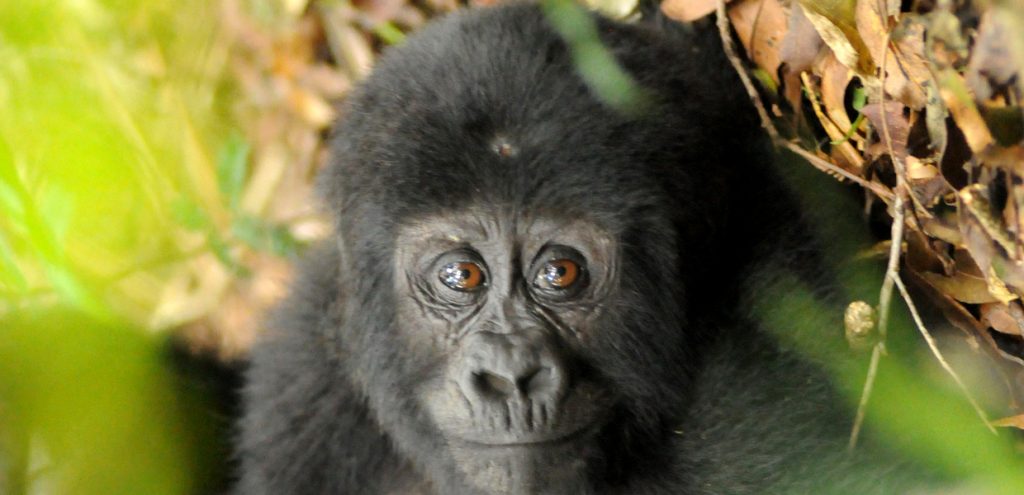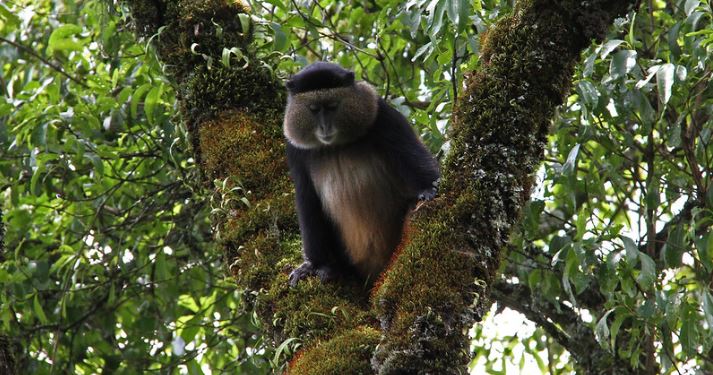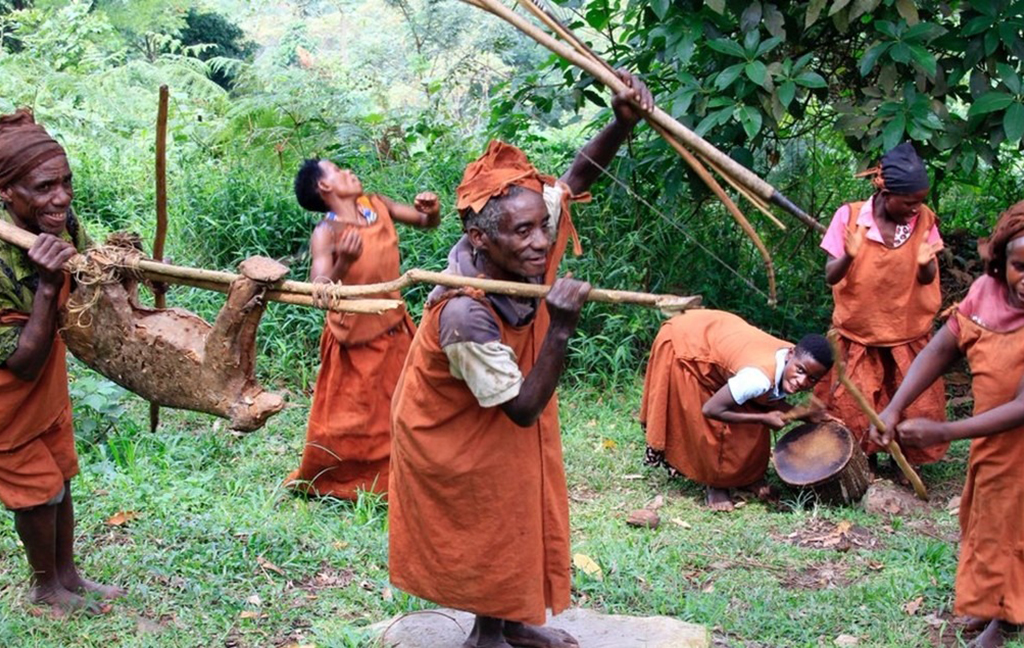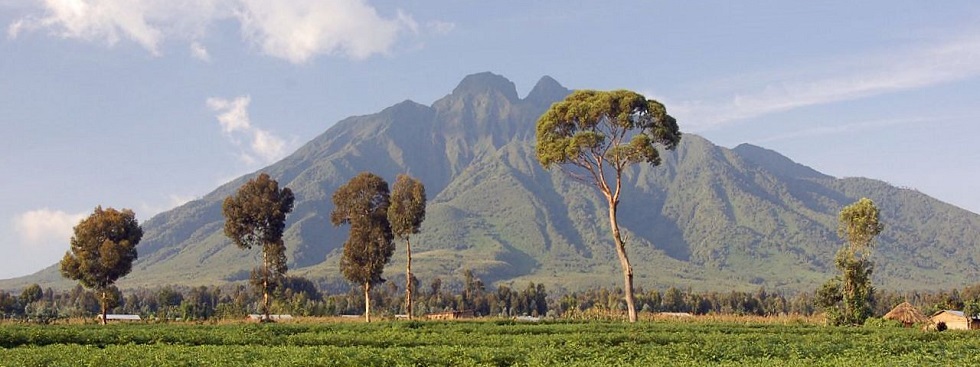Mgahinga Gorilla National Park
Is strikingly beautiful. Covering 33.7 km², Uganda’s smallest national park offers a rich bounty of wildlife, culture and dramatic scenery.
Encircled by three conical, inactive volcanoes – Mount Muhabura, Mount Gahinga and Mount Sabyinyo – Mgahinga’s dense forests are home to Uganda’s famed mountain gorillas and endangered golden monkeys, as well as leopards, elephants and buffalo.
A startling 79 varieties of bird nest within Mgahinga’s varied ecosystems, including the Rwenzori turaco, crowned hornbill and crowned crane.
Animal Life
Mgahinga National Park’s most notable creatures are the Mountain gorillas and the endangered golden monkeys.
There is a whole host of other forest creatures to see including buffaloes, elephants, giant forest hogs, bushbucks, leopards, spotted hyenas, black fronted duikers, South African porcupines, bush pigs, golden cats, side striped jackals.
In total there are about 79 bird species, such as the handsome francolin, dusky crimson-wing, red-throated alethe, Kivu ground thrush, Rwenzori turaco, Rwenzori batis, Rwenzori double-collared sunbird, collared apalis, mountain masked apalis, Archer’s ground robin, stripe-breasted tit, blue-headed sunbird, regal sunbird, strange weaver, montane nightjar, red-faced woodland warbler, Grauer’s swamp warbler.
Activities and Culture
The Mgahinga Mountain Gorillas

Mgahinga Gorilla National Park is home to more than half of the world’s population (over 600) of the endangered mountain gorilla. Fortunately for the gorillas, they are the main reason as to why the park was created by the Ugandan government.
Currently there is only one habituated gorilla group that can be visited by the tourists – Nyakagezi Gorilla Group.
Mountain gorillas being mobile animals makes tracking them difficult at times. It can take about 1 to 8 hours of hiking the forest depending on their movement and following their trails as directed by the rangers.
Gorilla tracking can be strenuous and may take the whole day. The guide leads you through the gorilla’s world, explaining aspects of their ecology and behaviour along the way.
Golden Monkey Tracking

These creatures are endemic to the Albertine Rift and are characterised as a bright orange-gold body, cheeks and tail, contrasting with its black limbs, crown and tail end.
Golden monkey tracking starts with tourists arriving at the Park headquarters by 7:30am for pre-tracking briefing (on the dos and don’ts of tracking the golden monkeys). The actual trek begins at 8:00am.
Hiking through the forests to sight the golden monkeys is not as strenuous as gorilla trekking because golden monkeys live in lower areas, so tourists are unlikely to trek for more than 3 hours.
When tourists encounter the golden monkey family, they are given one hour to spend with them (to take photographs from a distance and observe their behavior).
There is no minimum number of tourists who can track each group and age limit is 12 years.
The Batwa Trail
With the cultural trail in Mgahinga National Park, you will be able to experience the ancient ways of the Batwa people who once lived within the forest and explore their ancient cultures.

The Batwa were the original inhabitants of the forests before Mgahinga and Bwindi Impenetrable National Park were gazetted into National Parks in 1991. The Batwa Trail leads from the base of Muhuvura Cave.
The walk is a living museum where you can learn about the Batwa People, a pygmoid tribe that used to live in the Mgahinga National Park. These people were hunter-gatherers and fierce warriors who depended on the forest for shelter, food and medicine.
This walk is conducted by Batwa guides who provide insights into their traditional forest life and culture. The Batwa demonstrate a range of activities from past hunting techniques to their ways of gathering honey. The guides will point out the medicinal plants that were used and demonstrate how to make bamboo cups.
Guests are finally invited to the sacred Ngarama Cave, once home to the Batwa King. The women of the community perform a cultural dance and you are even encouraged to participate!
The Virunga Mountains
This amazing range offers magnificent scenery and opportunities for hiking to travellers visiting the park, whether you are a seasoned mountain climber or starter. There are three peaks:
Mt. Sabyinyo (3669m) ‘Old man’s teeth’ – Like an old man’s teeth, time and weather have eroded Mt. Sabyinyo’s crown.
This volcano offers 3 challenging peaks to climb. A climb up the mountain takes one up abridge along the eastern side of the climb to peak. If you are to continue, the climb to the peak involves walking a ridge with breath-taking plunges into the gorges of Rwanda and Uganda.
Finally, the hike up to the peak can get steep with several ladders involved and some determination required. You are guaranteed to get your hands dirty en-route to the summit!
Once on top, you will be in Rwanda, Democratic Republic of Congo and Uganda. The journey takes about eight hours round trip to cover the entire 14km stretch.
Mt. Gahinga (3474m) – On your way to the park, look out for small piles of stones in the garden fields that the local people call a ‘Gahinga’. The name Gahinga was also the reason for the naming of the National Park within which it is situated.
Mount Gahinga is far bigger than the average ‘gahinga’ but standing at the top of Mount Muhavura will make it look small in comparison. A hike, which takes you about, six hours round trip, goes through a good example of a pure Bamboo forest.

Gahinga once had a Crater Lake on top but time has changed it into a Lush swamp. The distance to the swamp is 8km.
Mt. Muhavura (4127m) ‘The Guide’ – The typical cone-shaped Mountain provides some of the best views in the country.
Much of the climb passes a rocky surface covered by grasses and small shrubs. Once at the top, hikers are rewarded with the view of the other Virunga volcanoes, Lake Edward in queen Elizabeth National Park, Bwindi and the peaks of Rwenzori Mountain.
The hike takes approximately 8 hours round trip covering 12km. You are advised to camp at the Muhavura base camp the night before the site has no facilities so you need a tent, water, food and sleeping gear.
Garama Cave Exploration
The 342m long Garama Cave lies beneath a plateau northern edge of the park, 3 kilometres from Ntebeko. It is set in the former farmland zone but in earlier times, the cave forest when it was occupied periodically by Batwa who used it as a council chamber and a retreat.
On a guided walk, your guide will show you how the Batwa lived and fought out of the cave. The cave is now inhabited only by bats. There is a viewing platform 800m from the Park’s gate.
On arriving at it, you’ll be rewarded with splendid views of the Park as well as its surrounding. This activity is free of charge and does not need a guide.
Birding
Mgahinga Gorilla National Park is ideal for birding. Buffalo Wall is one of the best points for bird watching here. Some of the birds to see include the ibis, speckled mous, fire finch and others.
Getting there
Roads
Mgahinga gorilla national park is 524km from kampala . a surfaced high way runs via mbarara and kabale to Kisoro is awinding drive through mountainous terrain with steep ascents and descents.beyond Kisoro , a rough ,14km road with steep ,rocky section ascends to the park headquarters at ntebeko
By air
Mgahinga can also bereached by daily flights from Entebbe International Airport to Kisoro airfield
Gallery





